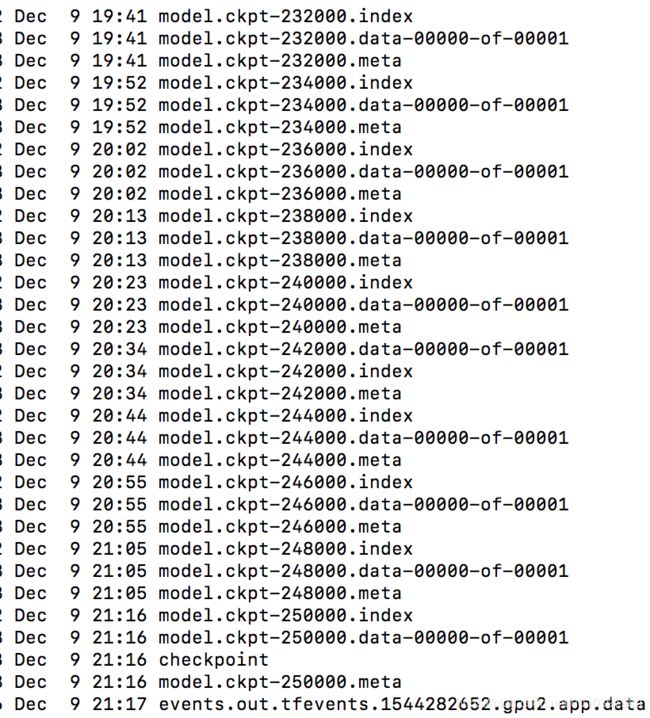18.2:tensorflow分类模型mobilenetv2训练(数据增强,保存模型,衰减学习率,tensorboard),预测图像(单张,批量预测),导出为pb完整示例
二、预测
经过一段时间的训练后在model_save文件夹下保存了下面的模型:
他想使用model.ckpt-250000模型对数据进行预测。
他写了个predict.py程序为:
#coding:utf-8
import os, cv2
#os.environ["CUDA_VISIBLE_DEVICES"] = "-1" # use cpu
import numpy as np
import tensorflow as tf
from PIL import Image
import matplotlib.pyplot as plt
import glob
import model
config = tf.ConfigProto()
config.gpu_options.allow_growth = True
os.environ["CUDA_VISIBLE_DEVICES"] = "0" # use gpu 0
label_dict, label_dict_res = {}, {}
with open("label.txt", 'r') as f:
for line in f.readlines():
folder, label = line.strip().split(':')[0], line.strip().split(':')[1]
label_dict[folder] = label
label_dict_res[label] = folder
print(label_dict)
N_CLASSES = len(label_dict)
IMG_W = 224
IMG_H = IMG_W
def init_tf(logs_train_dir = './model_save/model.ckpt-250000'):
global sess, pred, x
# process image
x = tf.placeholder(tf.float32, shape=[IMG_W, IMG_W, 3])
x_norm = tf.image.per_image_standardization(x)
x_4d = tf.reshape(x_norm, [-1, IMG_W, IMG_W, 3])
# predict
logit = model.MobileNetV2(x_4d, num_classes=N_CLASSES, is_training=False).output
print("logit", np.shape(logit))
#logit = model.model4(x_4d, N_CLASSES, is_trian=False)
#logit = model.model2(x_4d, batch_size=1, n_classes=N_CLASSES)
pred = tf.nn.softmax(logit)
saver = tf.train.Saver()
sess = tf.Session(config=config)
saver.restore(sess, logs_train_dir)
print('load model done...')
def evaluate_image(img_dir):
# read image
im = cv2.imread(img_dir)
im = cv2.cvtColor(im, cv2.COLOR_BGR2RGB)
im = cv2.resize(im, (IMG_W, IMG_W))
image_array = np.array(im)
prediction = sess.run(pred, feed_dict={x: image_array})
max_index = np.argmax(prediction)
pred_label = label_dict_res[str(max_index)]
print("%s, predict: %s(index:%d), prob: %f" %(img_dir, pred_label, max_index, prediction[0][max_index]))
if __name__ == '__main__':
init_tf()
data_path = "/media/DATA2/sku_val"
label = os.listdir(data_path)
for l in label:
if os.path.isfile(os.path.join(data_path, l)):
continue
for img in glob.glob(os.path.join(data_path, l, "*.jpg")):
evaluate_image(img_dir=img)
sess.close()
他嫌一张张输入有点慢,于是改了以下代码,让一次输入一个batch。命名为predict_batch.py
#coding:utf-8
import os, cv2, time
#os.environ["CUDA_VISIBLE_DEVICES"] = "-1" # use cpu
import numpy as np
import tensorflow as tf
from PIL import Image
import matplotlib.pyplot as plt
import glob
import model
label_dict, label_dict_res = {}, {}
with open("label.txt", 'r') as f:
for line in f.readlines():
folder, label = line.strip().split(':')[0], line.strip().split(':')[1]
label_dict[folder] = label
label_dict_res[label] = folder
print(label_dict)
N_CLASSES = len(label_dict)
IMG_W = 224
IMG_H = IMG_W
batch_size = 16
os.environ["CUDA_VISIBLE_DEVICES"] = "0" # use gpu 0
config = tf.ConfigProto()
config.gpu_options.allow_growth = True
def get_imgpath(path):
img_list = []
for fpath , dirs , fs in os.walk(path):
for f in fs:
img_path = os.path.join(fpath , f)
if os.path.dirname(img_path) == os.getcwd():
continue
if not os.path.isfile(img_path):
continue
if os.path.basename(img_path)[-3:] == "jpg":
img_list.append(img_path)
return img_list
def init_tf(logs_train_dir = './model_save/model.ckpt-140000'):
global sess, pred, x
# process image
x = tf.placeholder(tf.float32, shape=[None, IMG_W, IMG_W, 3], name="input_1")
# predict
logit = model.MobileNetV2(x, num_classes=N_CLASSES, is_training=False).output
#logit = model.model4(x, N_CLASSES, is_trian=False)
#logit = model.model2(x_4d, batch_size=1, n_classes=N_CLASSES)
pred = tf.nn.softmax(logit, name="pred")
saver = tf.train.Saver()
sess = tf.Session(config=config)
saver.restore(sess, logs_train_dir)
print('load model done...')
def evaluate_image(img_dir):
# read and process image
batch_img = []
for img in img_dir:
im = cv2.imread(img)
im = cv2.cvtColor(im, cv2.COLOR_BGR2RGB)
im = cv2.resize(im, (IMG_W, IMG_W))
im_mean = np.mean(im)
stddev = max(np.std(im), 1.0/np.sqrt(IMG_W*IMG_H*3))
im = (im - im_mean) / stddev
image_array = np.array(im)
batch_img.append(image_array)
# output sotfmax
prediction = sess.run(pred, feed_dict={x: batch_img})
for i in range(len(img_dir)):
img = img_dir[i]
max_index = np.argmax(prediction[i])
print("img:%s, predict: %s, prob: %f" % (img, label_dict_res[str(max_index)], prediction[i][max_index]))
if __name__ == '__main__':
init_tf()
data_path = "/media/DATA2/sku_val"
img_list = get_imgpath(data_path)
print("there are %d images in %s" %(len(img_list), data_path))
total_batch = len(img_list)/batch_size
start = time.time()
for i in range(total_batch):
print(str(i) + "-"*50)
batch_img = img_list[i*batch_size: (i+1)*batch_size]
evaluate_image(batch_img)
print("time cost:", time.time()-start)
sess.close()
